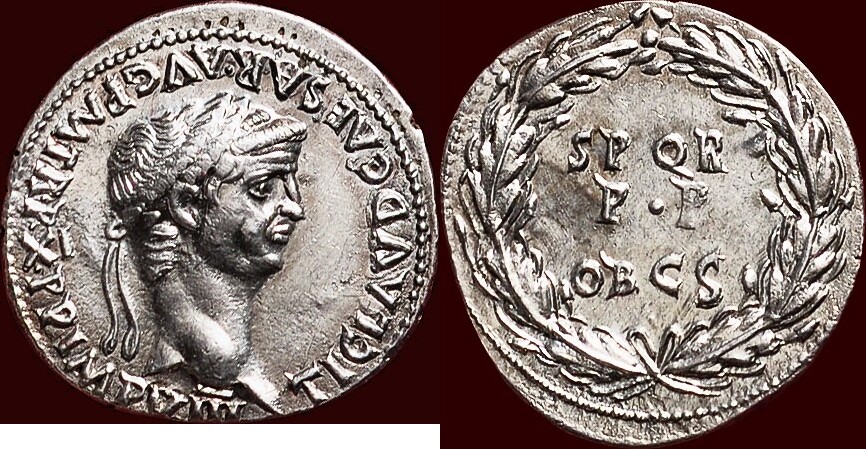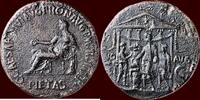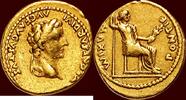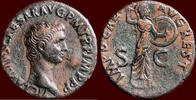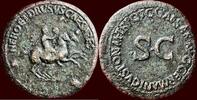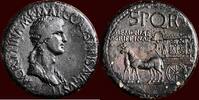MA-ID: 8435802010
Bewertungen Henzen
Schnelle Lieferung. Super Ware. Vielen Dank!
O.K.
perfekt !!!
Great coin, quick delivery, thanks!
Roman Empire AE Denarius (ca. 50-53) CLAUDIUS, 41-54 – AR/ traveling military mint in Britain cf. NAC 125, lot 630 (in xf+ SFR 22.000 + 21%)
Munthandel G.Henzen 

10
Seit 10 Jahren bei MA-Shops
7244 Bewertungen,
100 % Positiv (seit 24 Monaten)
Weltweiter Versand
11000,00 EUR
Differenzbesteuert nach §25a UStG
zzgl. 18,00 EUR Versand ( nach Deutschland )
Lieferzeit: 5 - 8 Tage*
zzgl. 18,00 EUR Versand ( nach Deutschland )
| Bestellhotline +49 (0)2871 2180 383 |
| Zahlungsarten |
| Überweisung |
weight 3,03gr. | silver Ø 19mm.
obv. Laureate head of Claudius right, surrounded by the legend
TI CLAVD CAESAR AVG PM TR P X P P IMP VIII
rev. SPQR / P • P / OB CS in oak-wreath (Corona Civica)
The first Roman emperor to have been born outside Rome, Claudius was the youngest of the three surviving children of Drusus and Antonia Minor. While still very young, Claudius became disabled after suffering an illness, which caused his family (especially his mother) to disdain him. He was not permitted in the public eye, and unlike other sons of the imperial household, he was kept out of politics. It was this same disability, however, that probably saved him from the intrigues at court that proved fatal to so many of his relatives during the reigns of Tiberius and Caligula by the time he was elevated to the throne by the Praetorian Guard after Caligula′s assassination, he was the last surviving male of his family. Despite having little experience in politics, Claudius had a keen and scholarly intellect, and soon proved himself an able administrator. He respected the senate and declined many honours traditionally bestowed on an emperor, preferring to earn them instead, and he initiated extensive public works that were necessary and beneficial. Despite his effectiveness as ruler, however, it seems Claudius possibly fell victim to the intrigues of his fourth wife, Agrippina the Younger: wanting her own son, Nero, to succeed her husband on the throne, she fed Claudius a dose of poisonous mushrooms. Or so the story goes. Seneca said that Claudius died of natural causes, and as he was already 64 at the time of his death and an alcoholic, it may be that he simply succumbed to infirmity and old age. The portrait of Claudius on this coin is finely executed and of a very high artistic calibre, such that it exudes the essence of Julio-Claudian portraiture in the round. This is not often the case with Claudius′ coin portraits: although some do exhibit a high degree of artistic merit, most lack the refined execution of style that this coin exhibits. The reverse reads ″SPQR P P OB CS″, meaning ″Senatus Populusque Romanus″ (the Roman Senate and people), ″Pater Patriae″ (to the father of his country), ″Ob Cives Servatos″ (For having saved the citizens). The Corona Civica was originally a military honour bestowed upon a Roman who had saved a fellow citizen′s life in battle. It was one of the greatest public honours. In the imperial era the honour developed from a coveted military decoration into an imperial emblem granted by the Senate to the emperor. The wreath was made of oak leaves and is sometimes called a corona quercea after the common name for the oak. Plutarch believed the oak was chosen for this highest of honours for several reasons. The tree was easily found throughout the countryside and was quite convenient for fashioning a wreath when the need arose. Also, the oak is sacred to Jupiter and Juno and thus was an appropriate symbolic honour given to one who has saved the life of a fellow Roman citizen. Finally, the early settlers of Rome, the Arcadians, were nicknamed ′acorn-eaters′ in an oracle of Apollo. It harkens back to the declarations of gratitude conferred on Augustus in 27 BC, when the senate awarded him the corona civica (civic wreath | here represented by the oak wreath enclosing the inscription on the reverse) and the clipeus virtutis (shield of valour). This silver denarius has a copper core. It concerns here a so-called subaeratus denarius. This silver-plated denarius was likely produced at an "unofficial" mint in Britain somewhat after the Claudian invasion of AD 43. The sudden arrival of tens of thousands of Romans in the new-won province produced a soaring demand for coinage that was answered on the local level by the striking of bronze sestertii and copper asses, as well as plated denarii of this type. While not sanctioned by the Roman government, the practice was likely "winked at" by the authorities until greater stores of specie were imported. A hoard of 110 plated denarii of this type was found in Waveny, Suffolk in 1996. Historically highly interesting and extremely rare denarius.
♦ A superb Claudius denarius from Britain ♦
Denarii of Claudius in high quality are quite exceptional and very hard to find.
cf. NAC 125, lot 630 (in xf+ SFR 22.000 + 21%)
Cohen - | RIC - (cf. 60) | BMC - | Sear- (cf.1848) RRR
Minor planchet fault. Wonderful lustrous coin with excellent details.
Near mintstate
xf/unc
obv. Laureate head of Claudius right, surrounded by the legend
TI CLAVD CAESAR AVG PM TR P X P P IMP VIII
rev. SPQR / P • P / OB CS in oak-wreath (Corona Civica)
The first Roman emperor to have been born outside Rome, Claudius was the youngest of the three surviving children of Drusus and Antonia Minor. While still very young, Claudius became disabled after suffering an illness, which caused his family (especially his mother) to disdain him. He was not permitted in the public eye, and unlike other sons of the imperial household, he was kept out of politics. It was this same disability, however, that probably saved him from the intrigues at court that proved fatal to so many of his relatives during the reigns of Tiberius and Caligula by the time he was elevated to the throne by the Praetorian Guard after Caligula′s assassination, he was the last surviving male of his family. Despite having little experience in politics, Claudius had a keen and scholarly intellect, and soon proved himself an able administrator. He respected the senate and declined many honours traditionally bestowed on an emperor, preferring to earn them instead, and he initiated extensive public works that were necessary and beneficial. Despite his effectiveness as ruler, however, it seems Claudius possibly fell victim to the intrigues of his fourth wife, Agrippina the Younger: wanting her own son, Nero, to succeed her husband on the throne, she fed Claudius a dose of poisonous mushrooms. Or so the story goes. Seneca said that Claudius died of natural causes, and as he was already 64 at the time of his death and an alcoholic, it may be that he simply succumbed to infirmity and old age. The portrait of Claudius on this coin is finely executed and of a very high artistic calibre, such that it exudes the essence of Julio-Claudian portraiture in the round. This is not often the case with Claudius′ coin portraits: although some do exhibit a high degree of artistic merit, most lack the refined execution of style that this coin exhibits. The reverse reads ″SPQR P P OB CS″, meaning ″Senatus Populusque Romanus″ (the Roman Senate and people), ″Pater Patriae″ (to the father of his country), ″Ob Cives Servatos″ (For having saved the citizens). The Corona Civica was originally a military honour bestowed upon a Roman who had saved a fellow citizen′s life in battle. It was one of the greatest public honours. In the imperial era the honour developed from a coveted military decoration into an imperial emblem granted by the Senate to the emperor. The wreath was made of oak leaves and is sometimes called a corona quercea after the common name for the oak. Plutarch believed the oak was chosen for this highest of honours for several reasons. The tree was easily found throughout the countryside and was quite convenient for fashioning a wreath when the need arose. Also, the oak is sacred to Jupiter and Juno and thus was an appropriate symbolic honour given to one who has saved the life of a fellow Roman citizen. Finally, the early settlers of Rome, the Arcadians, were nicknamed ′acorn-eaters′ in an oracle of Apollo. It harkens back to the declarations of gratitude conferred on Augustus in 27 BC, when the senate awarded him the corona civica (civic wreath | here represented by the oak wreath enclosing the inscription on the reverse) and the clipeus virtutis (shield of valour). This silver denarius has a copper core. It concerns here a so-called subaeratus denarius. This silver-plated denarius was likely produced at an "unofficial" mint in Britain somewhat after the Claudian invasion of AD 43. The sudden arrival of tens of thousands of Romans in the new-won province produced a soaring demand for coinage that was answered on the local level by the striking of bronze sestertii and copper asses, as well as plated denarii of this type. While not sanctioned by the Roman government, the practice was likely "winked at" by the authorities until greater stores of specie were imported. A hoard of 110 plated denarii of this type was found in Waveny, Suffolk in 1996. Historically highly interesting and extremely rare denarius.
♦ A superb Claudius denarius from Britain ♦
Denarii of Claudius in high quality are quite exceptional and very hard to find.
cf. NAC 125, lot 630 (in xf+ SFR 22.000 + 21%)
Cohen - | RIC - (cf. 60) | BMC - | Sear- (cf.1848) RRR
Minor planchet fault. Wonderful lustrous coin with excellent details.
Near mintstate
xf/unc
Bitte beachten Sie unsere Mindestabnahme von 20 Euro. Sendungen nach China sind auf Gefahr des Käufers und nur Zahlung per banküberweisung. An PayPal und Kreditkarte Zahlungen sind immer Verwaltungs- und Risikokosten verbunden. Sendungen nach Russland, Ukraine und israel sind nicht möglich. Der Versand erfolgt innerhalb von 5 Tagen nach Zahlungseingang. BITTE KEIN PAYPAL ODER KREDITKARTE ZAHLUNGEN FÜR EU. Zahlen Sie bitte immer nur mit IBAN; schnell, billig und zuverlässich.
| Versandkosten | ||||
|---|---|---|---|---|
| bis 100,00 EUR | 100,00 EUR bis 500,00 EUR | 500,00 EUR bis 1000,00 EUR | über 1000,00 EUR | |
| Argentinien | 32,00 EUR | 32,00 EUR | 40,00 EUR | 40,00 EUR |
| Australien | 35,00 EUR | 35,00 EUR | 40,00 EUR | 40,00 EUR |
| Belgien | 9,50 EUR | 11,00 EUR | 13,00 EUR | 18,00 EUR |
| Brasilien | 55,00 EUR | 55,00 EUR | 55,00 EUR | 55,00 EUR |
| Bulgarien | 14,00 EUR | 16,00 EUR | 35,00 EUR | 45,00 EUR |
| Chile | 50,00 EUR | 50,00 EUR | 50,00 EUR | 50,00 EUR |
| China | 40,00 EUR | 40,00 EUR | 50,00 EUR | 50,00 EUR |
| Dänemark | 11,50 EUR | 13,00 EUR | 16,00 EUR | 20,00 EUR |
| Deutschland | 9,50 EUR | 11,00 EUR | 13,00 EUR | 18,00 EUR |
| Estland | 13,00 EUR | 14,00 EUR | 15,00 EUR | 25,00 EUR |
| Frankreich | 9,50 EUR | 11,00 EUR | 16,00 EUR | 25,00 EUR |
| Griechenland | 15,00 EUR | 25,00 EUR | 30,00 EUR | 35,00 EUR |
| Großbritannien | 25,00 EUR | 25,00 EUR | 26,00 EUR | 28,00 EUR |
| Hong Kong | 40,00 EUR | 40,00 EUR | 50,00 EUR | 50,00 EUR |
| Indien | 35,00 EUR | 35,00 EUR | 40,00 EUR | 50,00 EUR |
| Indonesien | 35,00 EUR | 35,00 EUR | 40,00 EUR | 40,00 EUR |
| Israel | 200,00 EUR | 200,00 EUR | 200,00 EUR | 200,00 EUR |
| Japan | 40,00 EUR | 40,00 EUR | 40,00 EUR | 40,00 EUR |
| Kambodscha | 65,00 EUR | 65,00 EUR | 65,00 EUR | 65,00 EUR |
| Kanada | 30,00 EUR | 30,00 EUR | 35,00 EUR | 35,00 EUR |
| Liechtenstein | 20,00 EUR | 20,00 EUR | 25,00 EUR | 25,00 EUR |
| Luxemburg | 11,00 EUR | 13,00 EUR | 16,00 EUR | 25,00 EUR |
| Malaysia | 35,00 EUR | 35,00 EUR | 40,00 EUR | 45,00 EUR |
| Niederlande | 8,50 EUR | 8,50 EUR | 11,00 EUR | 14,00 EUR |
| Norwegen | 25,00 EUR | 25,00 EUR | 30,00 EUR | 35,00 EUR |
| Österreich | 11,50 EUR | 12,50 EUR | 15,00 EUR | 25,00 EUR |
| Polen | 13,00 EUR | 14,00 EUR | 16,50 EUR | 25,00 EUR |
| Portugal | 13,00 EUR | 14,00 EUR | 18,00 EUR | 25,00 EUR |
| Rumänien | 16,00 EUR | 18,00 EUR | 25,00 EUR | 35,00 EUR |
| Russische Föderation | 200,00 EUR | 200,00 EUR | 200,00 EUR | 200,00 EUR |
| Schweiz | 30,00 EUR | 30,00 EUR | 40,00 EUR | 40,00 EUR |
| Serbien | 25,00 EUR | 25,00 EUR | 30,00 EUR | 35,00 EUR |
| Singapur | 35,00 EUR | 35,00 EUR | 35,00 EUR | 40,00 EUR |
| Slowakei | 13,00 EUR | 15,00 EUR | 20,00 EUR | 25,00 EUR |
| Spanien | 11,50 EUR | 13,50 EUR | 16,50 EUR | 25,00 EUR |
| Sri Lanka | 35,00 EUR | 35,00 EUR | 40,00 EUR | 45,00 EUR |
| Tschechische Republik | 12,00 EUR | 14,00 EUR | 18,00 EUR | 25,00 EUR |
| Ukraine | 200,00 EUR | 200,00 EUR | 200,00 EUR | 200,00 EUR |
| Ungarn | 14,00 EUR | 16,00 EUR | 25,00 EUR | 30,00 EUR |
| Vereinigte Staaten von Amerika | 32,00 EUR | 32,00 EUR | 35,00 EUR | 40,00 EUR |
| Europäische Union | 15,00 EUR | 17,00 EUR | 25,00 EUR | 30,00 EUR |
| Welt | 40,00 EUR | 40,00 EUR | 50,00 EUR | 50,00 EUR |
Informationen zum Kauf bei MA-Shops
Bestellungen bei MA-Shops sind jederzeit möglich und werden innerhalb von 2-4 Arbeitstagen verschickt.
Ein über die MA-Shops abgesicherter Kauf findet niemals außerhalb von MA-Shops statt.
Bestellen Sie sicher online mit dem MA-Shops Warenkorb.
Vielen Dank.
Ein über die MA-Shops abgesicherter Kauf findet niemals außerhalb von MA-Shops statt.
Bestellen Sie sicher online mit dem MA-Shops Warenkorb.
Vielen Dank.
|
Verkäufer-Startseite | 0Warenkorb | AGB | Impressum | MA AGB | Datenschutzerklärung | Garantie | MA-Shops Neuzugänge Copyright ® 2001-2025, MA-SHOPS Muenzen All Rights Reserved. Designated trademarks and brands are the property of their respective owners. |
 Münzen beim Fachhändler kaufen
Münzen beim Fachhändler kaufen


